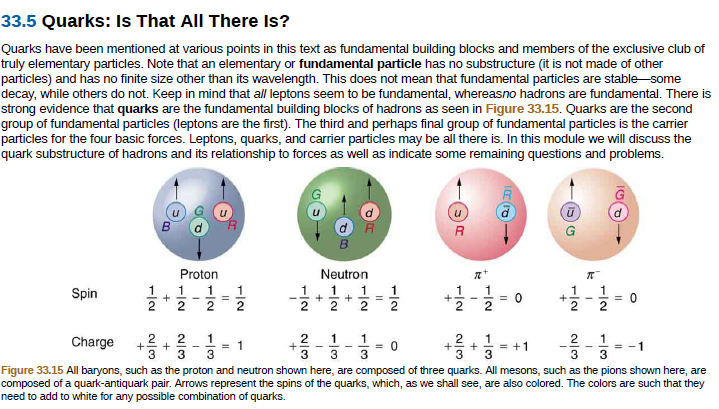33.5 Quarks: Is That All There Is? Quarks have been mentioned at various points in this text as fundamental building blocks and members of the exclusive club of truly elementary particles. Note that an elementary or fundamental particle has no substructure (it is not made of other particles) and has no finite size other than its wavelength. This does not mean that fundamental particles are stable some decay, while others do not. Keep in mind that all leptons seem to be fundamental, whereasno hadrons are fundamental. There is strong evidence that quarks are the fundamental building blocks of hadrons as seen in Figure 33.15. Quarks are the second group of fundamental particles (leptons are the first). The third and perhaps final group of fundamental particles is the carrier particles for the four basic forces. Leptons, quarks, and carrier particles may be all there is. In this module we will discuss the quark substructure of hadrons and its relationship to forces as well as indicate some remaining questions and problems. Proton Neutron Spin %3D 2 2 Charge 2 2 = +1 3 -1 3 3 3 3 Figure 33.15 All baryons, such as the proton and neutron shown here, are composed of three quarks. All mesons, such as the pions shown here, are composed of a quark-antiquark pair. Arrows represent the spins of the quarks, which, as we shall see, are also colored. The colors are such that they need to add to white for any possible combination of quarks. 르3 -/2 -|3
33.5 Quarks: Is That All There Is? Quarks have been mentioned at various points in this text as fundamental building blocks and members of the exclusive club of truly elementary particles. Note that an elementary or fundamental particle has no substructure (it is not made of other particles) and has no finite size other than its wavelength. This does not mean that fundamental particles are stable some decay, while others do not. Keep in mind that all leptons seem to be fundamental, whereasno hadrons are fundamental. There is strong evidence that quarks are the fundamental building blocks of hadrons as seen in Figure 33.15. Quarks are the second group of fundamental particles (leptons are the first). The third and perhaps final group of fundamental particles is the carrier particles for the four basic forces. Leptons, quarks, and carrier particles may be all there is. In this module we will discuss the quark substructure of hadrons and its relationship to forces as well as indicate some remaining questions and problems. Proton Neutron Spin %3D 2 2 Charge 2 2 = +1 3 -1 3 3 3 3 Figure 33.15 All baryons, such as the proton and neutron shown here, are composed of three quarks. All mesons, such as the pions shown here, are composed of a quark-antiquark pair. Arrows represent the spins of the quarks, which, as we shall see, are also colored. The colors are such that they need to add to white for any possible combination of quarks. 르3 -/2 -|3
Related questions
Question
Quarks: Is That All There Is?
• Define fundamental particle.
• Describe quark and antiquark.
• List the flavors of quark.
• Outline the quark composition of hadrons.
• Determine quantum numbers from quark composition.

Transcribed Image Text:33.5 Quarks: Is That All There Is?
Quarks have been mentioned at various points in this text as fundamental building blocks and members of the exclusive club of
truly elementary particles. Note that an elementary or fundamental particle has no substructure (it is not made of other
particles) and has no finite size other than its wavelength. This does not mean that fundamental particles are stable some
decay, while others do not. Keep in mind that all leptons seem to be fundamental, whereasno hadrons are fundamental. There is
strong evidence that quarks are the fundamental building blocks of hadrons as seen in Figure 33.15. Quarks are the second
group of fundamental particles (leptons are the first). The third and perhaps final group of fundamental particles is the carrier
particles for the four basic forces. Leptons, quarks, and carrier particles may be all there is. In this module we will discuss the
quark substructure of hadrons and its relationship to forces as well as indicate some remaining questions and problems.
Proton
Neutron
Spin
%3D
2
2
Charge
2
2
= +1
3
-1
3
3
3
3
Figure 33.15 All baryons, such as the proton and neutron shown here, are composed of three quarks. All mesons, such as the pions shown here, are
composed of a quark-antiquark pair. Arrows represent the spins of the quarks, which, as we shall see, are also colored. The colors are such that they
need to add to white for any possible combination of quarks.
르3
-/2
-|3
Expert Solution
This question has been solved!
Explore an expertly crafted, step-by-step solution for a thorough understanding of key concepts.
This is a popular solution!
Trending now
This is a popular solution!
Step by step
Solved in 2 steps
